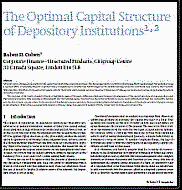(Published in WILMOTT MAGAZINE, Mar/Apr 2004, pp.38-49)
Ruben D. Cohen (e-mail)
Abstract
We
derive here a fundamental model for the capital structure of depository
institutions. The derivation centres
on the basic Modigliani-Miller [M&M] methodology, but instead of using
a constant EBIT, as classically done for corporate firms, it implements a
variable one, which hinges on the interest earnings from the asset-based loans
made to the borrower. Following this,
the effect of risk and credit spreads of both, the lender and borrower, are
introduced and the impact of leverage on certain basic ratios, in particular
the return on equity, is assessed.
The
outcome of this work is twofold.
Firstly, it highlights some of the main differences that exist between
the treatment of the capital structure of corporate firms and depository
institutions. And, secondly, it
demonstrates that the optimal capital structure of a depository institution is
not as easily identifiable as that of a corporate’s. The reasons for this include, among others, (i) the existence of
regulatory capital restrictions, (ii) an inter-dependence between the borrower
and the lender and (iii) a dramatic change in the behaviour of the return on
equity with respect to leverage when risks and credit spreads of both, lender
and borrower, are accounted for.
